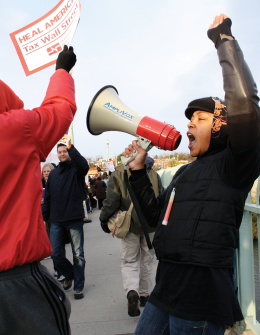
When about a dozen Occupy protesters settled in D.C.’sMacPherson Square Oct. 1, it seemed that they had appeared overnight.
But Michael Kazin, a history professor at Georgetown, believes that the movement was fated.
“There’s been a long critique for decades now about income inequality,” he said. “[The movement] was inevitable.”
Seven months later, the encampment is still home to a core group of protesters. The gradual growth of the D.C. branch of the Occupy protests has been mirrored by the development of Georgetown’s own Occupy group.
According to member Gina Bull (SFS ’12), Georgetown Occupy’s primary goal this year has been to strengthen activism on campus, particularly by establishing ties with organizations passionate about similar issues.
Members frequently join protests organized by the local movement, protesting in front of the White House and the Department of the Treasury and attending marches like that on the Key Bridge Nov. 17.
In late February, the group also organized a teach-in and has since established partnerships with other D.C. schools, including American University and The George Washington University.
According to member Rachel Nethery (COL ’12), Georgetown’s location has been integral in the ability to form such a coalition.
“Being in D.C., we have a lot of power that other groups … don’t have,” she said.
But she and Bull added that Georgetown Occupy has a role to play on campus as well, challenging the idea that protest is not a legitimate means of voicing discontent.
“A lot of people don’t consider activism … a normal resort,” Bull said. “It’s not a very mainstream activity at Georgetown … [and] we’re trying to get more Georgetown students to see that this is an appropriate and a more democratic form of representation.”
While attendance at the group’s twice-weekly meetings hovers around 15 regulars, Bull believes that the work it has done has been effective thus far.
According to Kazin, who is also a co-editor of the left-leaning magazine Dissent, college students are an integral part of the continuation of the Occupy movement because they are directly affected by national economic issues like student debt, low wages, the falling quality of public education and unemployment.
“There’s a question of where are jobs going to come from in the future, this fear that the finance industry … [is] going to be soaking up all the money and that a few people that are good with economics and money will be fine but that everyone else will be scrounging,” Kazin said.
Nethery and Bull both identified a need to challenge many Georgetown students’ definition of social justice as charity.
“I feel like philanthropy is good, but to make any substantial changes, you have to make changes to the system,” Nethery said.
Bull added that in the coming semester, Georgetown Occupy plans on developing its role as an umbrella organization for progressive student activism on campus and throughout D.C.
“I’m sure [Georgetown Occupy] is going to live on and be really strong,” she said.








